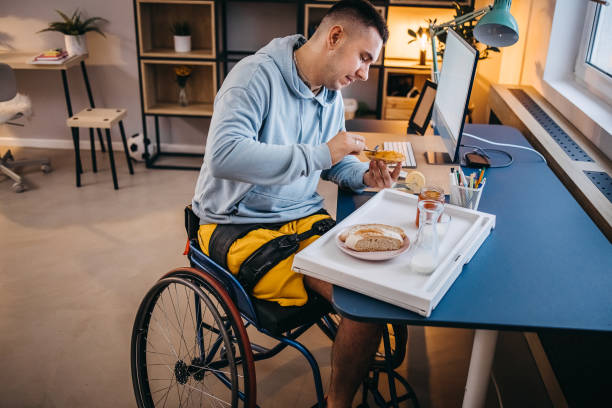Creating a home that adapts to the needs of individuals with Total Permanent Disability (TPD) is not just about functionality. It’s about crafting a space where independence and comfort coexist harmoniously.
This blog provides practical tips on how to adapt your home for greater accessibility and storage, ensuring that it meets the unique needs of those living with TPD. Whether you’re a homeowner looking to make your space more inclusive, an interior design enthusiast interested in accessibility solutions, or someone who loves organizing, this guide is for you.
The Importance of Accessible Homes
Living with TPD presents daily challenges that require thoughtful solutions within the home environment. Accessibility isn’t merely a buzzword; it’s a necessity that can significantly enhance the quality of life. Ensuring that every corner of the home is easy to access is key to fostering independence and safety. In this blog, we’ll explore various ways to make your home more adaptable, without sacrificing style or comfort.
Understanding the Basics of Accessibility
Accessibility in the home means more than just widening doorways or installing ramps. It involves a comprehensive approach that considers mobility, ease of use, and thoughtful design. Begin by assessing your current home layout. Identify areas that could pose challenges, like narrow hallways or high countertops. The goal is to create a seamless flow from room to room, ensuring each space is welcoming and functional.
Transformative Storage Solutions
Maximizing storage without compromising accessibility is essential. Think vertically with wall-mounted shelves that can easily be reached from a seated position. Consider pull-out cabinets in the kitchen to reduce the need for bending or reaching. Organized storage not only keeps your home tidy but also ensures that necessary items are always within arm’s reach, providing convenience and efficiency in daily tasks.
Elevating Access with Technology
Technology plays a pivotal role in enhancing accessibility. Automated systems for lighting, temperature, and security can be controlled with a smartphone or voice commands, eliminating the need for physical switches. In cities like Boise, Idaho, installing small home elevators can dramatically improve mobility between floors, providing a practical solution for multilevel homes. These innovations make daily living more manageable and enjoyable.
Kitchen Modifications for Accessibility
The kitchen is often the heart of the home, and making it accessible is crucial for individuals with TPD. Installing adjustable countertops allows for activities to be done comfortably whether sitting or standing. Lever-style handles on cabinets and drawers provide easier access than traditional knobs. A well-organized pantry with clearly labeled items can simplify meal preparation and promote independence.
Bathroom Accessibility Essentials
Bathrooms pose unique challenges when it comes to accessibility. Installing a walk-in shower with non-slip flooring can reduce the risk of accidents. Grab bars near the toilet and in the shower area provide additional support and stability. Consider a raised toilet seat for easier transfers, and ensure all toiletries and towels are within easy reach to maintain safety and autonomy.
Creating a Welcoming Entryway
Your home’s entryway sets the tone for accessibility. Ensure pathways to the front door are clear and wide enough for wheelchairs or walkers. A ramp or gentle slope can replace steps, offering a smoother transition into the home. Automatic door openers can further simplify entry and exit, making the space welcoming and easy to use for everyone.
Bedroom Comfort and Accessibility
In the bedroom, focus on creating a relaxing environment that supports ease of movement. Position the bed at a height that is comfortable for transferring. Nightstands should be within easy reach, with drawers that open smoothly. Consider an adjustable closet system that allows hanging rods and shelving to be lowered, putting clothing and accessories within easy access.
Living Room Layout for Ease of Movement
The living room should be designed for relaxation and easy navigation. Arrange furniture to allow wide pathways, facilitating movement without obstacles. Select seating that is firm and supportive, with armrests for additional leverage. Incorporate side tables that provide a stable surface for personal items, ensuring everything needed for comfort is close at hand.
Outdoor Accessibility Considerations
Don’t forget about outdoor spaces when planning for accessibility. Pathways should be level, with a firm, smooth surface to prevent falls. Raised garden beds can bring the joy of gardening to those with mobility challenges. If there are steps, consider adding a ramp or incline to make the area fully accessible, allowing for enjoyment of the outdoors without limitations.
Incorporating Personal Style in Accessible Design
Adapting your home for accessibility doesn’t mean compromising on style. Choose décor that reflects your personal taste while considering functionality. Use color and texture to add warmth and personality to each room. By integrating accessibility with aesthetics, you can create a home that is not only practical but also a true reflection of your unique style.
Conclusion
Adapting your home for Total Permanent Disability involves thoughtful planning and design choices that prioritize accessibility without sacrificing style. From storage solutions to technological enhancements, there are numerous ways to create a space that is both functional and inviting.
Whether you’re starting from scratch or making small adjustments, these tips can help you transform your home into a welcoming haven.
For more personalized advice, consider consulting with accessibility experts or interior designers who specialize in adaptive design. Creating an accessible home is a valuable investment in comfort, safety, and independence.

